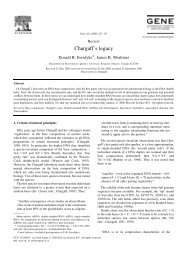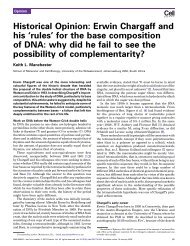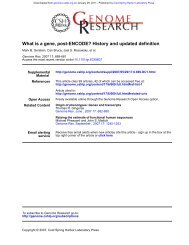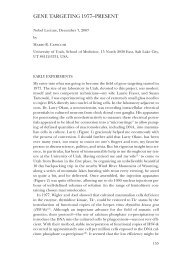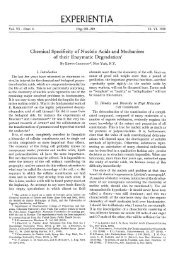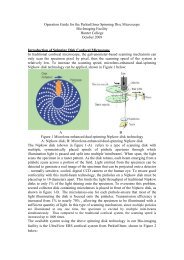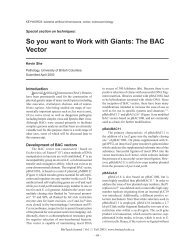Cold Spring Harb Symp Quant Biol-1953-Watson-SQB ... - Biology
Cold Spring Harb Symp Quant Biol-1953-Watson-SQB ... - Biology
Cold Spring Harb Symp Quant Biol-1953-Watson-SQB ... - Biology
You also want an ePaper? Increase the reach of your titles
YUMPU automatically turns print PDFs into web optimized ePapers that Google loves.
Downloaded from symposium.cshlp.org on March 26, 2009 - Published by <strong>Cold</strong> <strong>Spring</strong> <strong>Harb</strong>or Laboratory Press<br />
128 I. D. WATSON AND F. H. C. CRICK<br />
syntheses of these two components. We should like<br />
to propose instead that the specificity of DNA self<br />
replication is accomplished without recourse to specific<br />
protein synthesis and that each of our complementary<br />
DNA chains serves as a template or<br />
mould for the formation onto itself of a new companion<br />
chain.<br />
For this to occur the hydrogen bonds linking<br />
the complementary chains must break and the two<br />
chains unwind and separate. It seems likely that<br />
the single chain (or the relevant part of it) might<br />
itself assume the helical form and serve as a<br />
mould onto which free nucleotides (strictly polynucleotide<br />
precursors) can attach themselves by<br />
forming hydrogen bonds. We propose that polymerization<br />
of the precursors to form a new chain<br />
only occurs if the resulting chain forms the proposed<br />
structure. This is plausible because steric<br />
reasons would not allow monomers "crystallized"<br />
onto the first chain to approach one another in<br />
such a way that they could be joined together in a<br />
new chain, unless they were those monomers which<br />
could fit into our structure. It is not obvious to<br />
us whether a special enzyme would be required to<br />
carry out the polymerization or whether the existing<br />
single helical chain could act effectively as an<br />
enzyme.<br />
DIFFICULTIES IN THE REPLICATION SCHEME<br />
While this scheme appears intriguing, it nevertheless<br />
raises a number of difficulties, none of<br />
which, however, do we regard as insuperable. The<br />
first difficulty is that our structure does not differentiate<br />
between cytosine and 5-methyl cytosine, and<br />
therefore during replication the specificity in sequence<br />
involving these bases would not be perpetuated.<br />
The amount of 5-methyl cytosine varies<br />
considerably from one species to another, though<br />
it is usually rather small or absent. The present<br />
experimental results (Wyatt, 1952) suggest that<br />
each species has a characteristic amount. They also<br />
show that the sum of the two cytosines is more<br />
nearly equal to the amount of guanine than is the<br />
amount of cytosine by itself. It may well be that<br />
the difference between the two cytosines is not<br />
functionally significant. This interpretation would<br />
be considerably strengthened if it proved possible<br />
to change the amount of 5-methyl cytosine in the<br />
DNA of an organism without altering its genetical<br />
make-up.<br />
The occurrence of 5-hydroxy-methyl-cytosine in<br />
the T even phages (Wyatt and Cohen, 1952) presents<br />
no such difficulty, since it completely replaces<br />
cytosine, and its amount in the DNA is<br />
close to that of guanine.<br />
The second main objection to our scheme is that<br />
it completely ignores the role of the basic protamines<br />
and histories, proteins known to be combined<br />
with DNA in most living organisms. This was done<br />
for two reasons. Firstly, we can formulate a scheme<br />
of DNA reproduction involving it alone and so<br />
from the viewpoint of simplicity it seems better to<br />
believe (at least at present) that the genetic specificity<br />
is never passed through a protein intermediary.<br />
Secondly, we know almost nothing about the<br />
structural features of protamines and histories. Our<br />
only clue is the finding of Astbury (1947) and of<br />
Wilkins and Randall (<strong>1953</strong>) that the X-ray pattern<br />
of nucleoprotamine is very similar to that of DNA<br />
alone. This suggests that the protein component,<br />
or at least some of it, also assumes a helical form<br />
and in view of the very open nature of our model,<br />
we suspect that protein forms a third helical chain<br />
between the pair of polynucleotide chains (see Figure<br />
4). As yet nothing is known about the function<br />
of the protein; perhaps it controls the coiling<br />
and uncoiling and perhaps it assists in holding<br />
the single polynucleotide chains in a helical configuration.<br />
The third difficulty involves the necessity for the<br />
two complementary chains to unwind in order to<br />
serve as a template for a new chain. This is a very<br />
fundamental difficulty when the two chains are interlaced<br />
as in our model. The two main ways in<br />
which a pair of helices can be coiled together have<br />
been called plectonemic coiling and paranemic coiling.<br />
These terms have been used by cytologists to<br />
describe the coiling of chromosomes (Huskins,<br />
1941; for a review see Manton, 1950). The type of<br />
coiling found in our model (see Figure 4) is called<br />
plectonemic. Paranemic coiling is found when two<br />
separate helices are brought to lie side by side<br />
and then pushed together so that their axes roughly<br />
coincide. Though one may start with two regular<br />
helices the process of pushing them together neces.<br />
sarily distorts them. It is impossible to have para.<br />
nemic coiling with two regular simple helices going<br />
round the same axis. This point can only be<br />
clearly grasped by studying models.<br />
There is of course no difficulty in "unwinding"<br />
a single chain of DNA coiled into a helix, since a<br />
polynucleotide chain has so many single bonds<br />
about which rotation is possible. The difficulty occurs<br />
when one has a pair of simple helices with a<br />
common axis. The difficulty is a topological one<br />
and cannot be surmounted by simple manipulation.<br />
Apart from breaking the chains there are only two<br />
sorts of ways to separate two chains coiled plectonemically.<br />
In the first, one takes hold of one end<br />
of one chain, and the other end of the other, and<br />
simply pulls in the axial direction. The two chains<br />
slip over each other, and finish up separate and<br />
end to end. It seems to us highly unlikely that this<br />
occurs in this case, and we shall not consider it<br />
further. In the second way the two chains must<br />
be directly untwisted. When this has been done<br />
they are separate and side by side. The number of<br />
turns necessary to untwist them completely is equal<br />
to the number of turns of one of the chains round<br />
the common axis. For our structure this comes to<br />
one turn every 34 A, and thus about 150 turns per<br />
million molecular weight of DNA, that is per 5000



